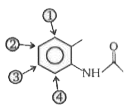What is catenation ? Why is it most prominent for carbon ?
Step-by-Step Text Solution:
Step 1: Define Catenation
Catenation is the ability of an element to form chains or rings by bonding with atoms of the same element. This occurs when atoms of the same element connect with each other to create long or branched structures.
Step 2: Identify the Element in Question
In this context, we are focusing on carbon, which is known for its exceptional ability to catenate.
Step 3: Explain Why Catenation is Prominent for Carbon
Catenation is most prominent for carbon due to two main reasons:
1. Tetravalency of Carbon: Carbon has four valence electrons, allowing it to form four covalent bonds with other atoms. This tetravalency enables carbon to bond with other carbon atoms, creating long chains or complex structures.
2. Strength of Carbon-Carbon Bonds: The covalent bonds formed between carbon atoms (specifically the sigma bonds) are relatively strong. This strength allows carbon to form stable chains and rings, making it capable of creating longer and more complex structures than most other elements.
Step 4: Conclusion
Due to its tetravalency and the strength of its carbon-carbon bonds, carbon exhibits a high degree of catenation, enabling it to form a vast array of organic compounds.
Catenation is the ability of an element to form chains or rings by bonding with atoms of the same element. This occurs when atoms of the same element connect with each other to create long or branched structures.
In this context, we are focusing on carbon, which is known for its exceptional ability to catenate.
Catenation is most prominent for carbon due to two main reasons:
Due to its tetravalency and the strength of its carbon-carbon bonds, carbon exhibits a high degree of catenation, enabling it to form a vast array of organic compounds.
Topper's Solved these Questions
- BOOK - ICSECHAPTER - ORGANIC CHEMISTRY : SOME BASIC PRINCIPLES AND TECHNIQUES EXERCISE - ESSAY ( LONG ANSWER ) TYPE QUESTIONS42videos
ORGANIC CHEMISTRY : SOME BASIC PRINCIPLES AND TECHNIQUES
- BOOK - ICSECHAPTER - ORGANIC CHEMISTRY : SOME BASIC PRINCIPLES AND TECHNIQUES EXERCISE - OBJECTIVE ( MULTIPLE CHOICE ) TYPE QUESTIONS142videos
ORGANIC CHEMISTRY : SOME BASIC PRINCIPLES AND TECHNIQUES
- BOOK - ICSECHAPTER - ORGANIC CHEMISTRY : SOME BASIC PRINCIPLES AND TECHNIQUES EXERCISE - VERY SHORT ANSWER TYPE QUESTIONS87videos
ORGANIC CHEMISTRY : SOME BASIC PRINCIPLES AND TECHNIQUES
- BOOK - ICSECHAPTER - HYDROGENEXERCISE - NCERT TEXT-BOOK EXERCISE (With Hints and Solutions)53videos
HYDROGEN
- BOOK - ICSECHAPTER - REDOX REACTIONS (OXIDATION AND REDUCTION)EXERCISE - NCERT TEXT-BOOK. EXERCISES ((With Hints and Solutions)69videos
REDOX REACTIONS (OXIDATION AND REDUCTION)
Similar Questions
Knowledge Check
- Question 1 - Select One
The tendency to form pπ−pπ multiple bonds in group 14 is
most prominent forACBSiCSnDPb - Question 2 - Select One
 Sulphonation is most favourable at the carbon number.... A1B2C3D4
Sulphonation is most favourable at the carbon number.... A1B2C3D4
What do you understand by catenation ? How does the property vary in group 14?
View SolutionCatenation is the ability of an atom to form bonds with other atoms of the same element . It is exhibited by both carbon and silicon. Compare the ability of catenation of the two elements .Give reasons.
View SolutionWhat is meant by catenation? How does the catenation tendency for elements of group 14 vary?
View SolutionExplaing why carbon forms compounds mainly by covalent bond. Explain in brief two main reasons for carbon forming a large number of compounds. Why does carbon form strong bonds with most other elements ?
View SolutionThe order of catenation power is
View SolutionThe order of catenation power is
View Solution

